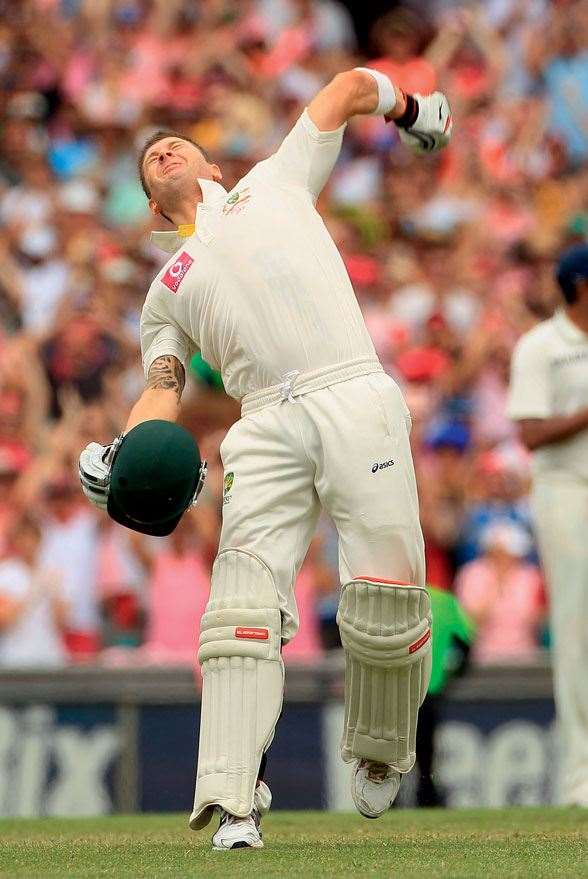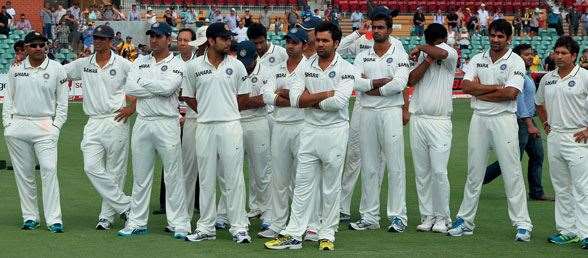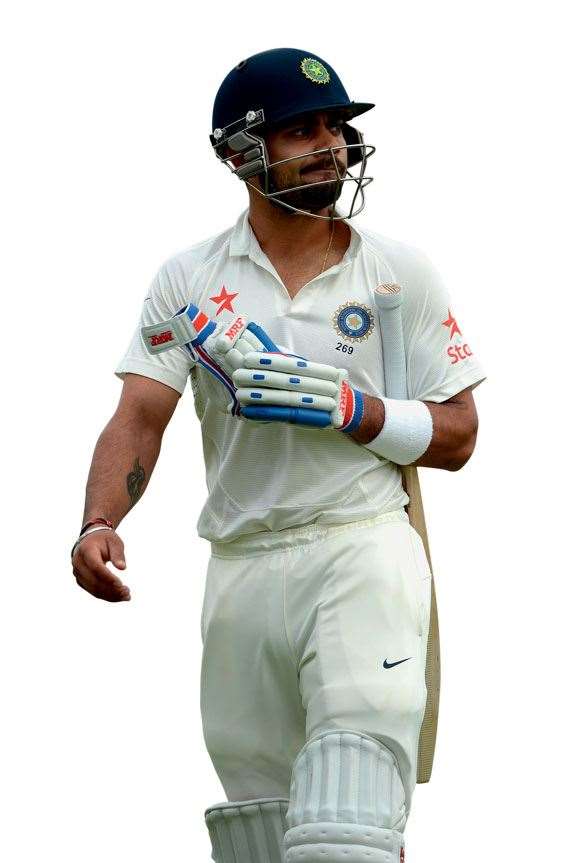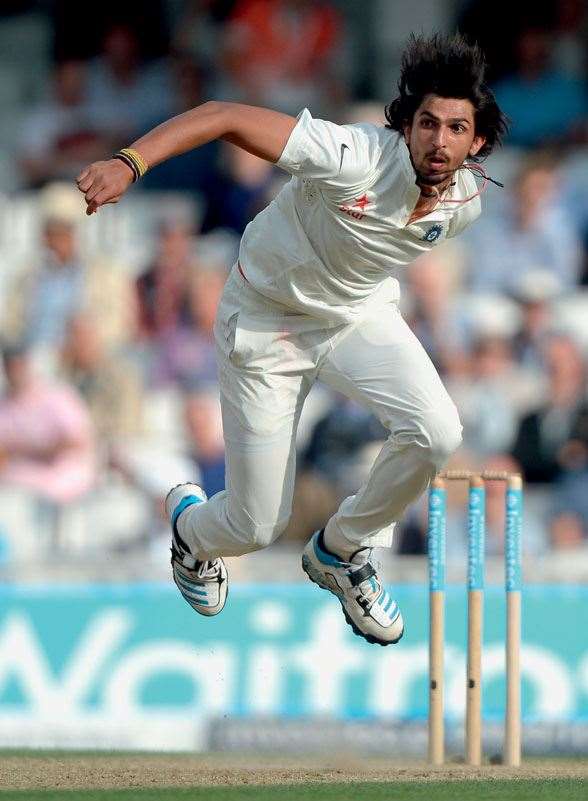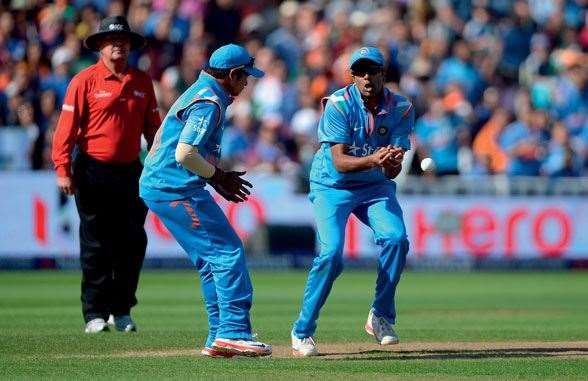With India's terrible touring record, Pup and his men will have to work hard to spin this series ...
AND SO COMETH INDIA for the Border-Gavaskar Trophy series, and you could spin it several ways. You might pump it as Dave “The Destroyer” Warner versus ol’ Crazy Eyes, Ishant Sharma. As slashin’ Stevie Smith leaping out to launch the crafty, finger-flickin’ goodness of old mate with one initial, R. Ashwin. As Australia’s howling, killer attack squad of death-flingin’ devil dogs (if you will) splattering the canvas of our juicy-fruit decks with the blood of India’s haughty, loose-wristed stroke-merchants. Or as Australia-You-Bloody-Beauty versus Mighty Thrusting India, two countries more different than Sweden and the Sudan, but which share a love-life with the great game via the benevolent dictatorship of a one-time colonial super-power.
So you could spin it like that ...
Or you could suggest that India are a bit shit and will be flogged four-nil. Whoa, back up. A b-b-bit ... what?
You heard me, Bubba. India are a bit shit and will lose this Test series four-nil. If it was five Tests they’d lose five-nil. Take the equity in your home and get on it with Centrebet.
Actually, do not do that. Because it may rain. A lot. The oceans are warming, condensation is rising into the sky and forming clouds which float over our hot, desert land, and fall as rain upon the earth. And thus there may be floods. Or there may be fires. Floods may wash out the fires. We cannot know.
But know this: if there are not sufficient disasters, India will not be saved from disaster. Because India are a bit shit, at least outside India. At home they’re unbeatable. At home they’re the All Blacks at Eden Park. But they travel worse than milk in a ute. In their last 19 Tests away, they’ve lost 13, drawn five and won one.
Of course, we’ll watch anyway and we’ll do it in numbers, because it’s India and it’s summer, and summer is cricket. Summer in Australia, the game is just on, wallpaper, the background noise of our very lives. We turn on the box in November and watch cricket until footy starts again in March. And we consume it every single mother-lovin’ day.
India will rate here even though last time in Australia they lost four-nil. Even though in August in England they lost three-one. And the Pommies’ attack, it’s over, baby. The Poms are over. Jimmy Anderson (32) and Stuart Broad (28) are still bowling on in – rapid, handy people. Next up are seamers Chris Jordan and Chris Woakes, neither of whom would get a start with Randwick-Petersham.
Kidding. Yes they would. But hark back: India lost the fourth Test within three days by an innings and 54 runs. First innings of the last Test, England rolled India for 148. Eighty-two of those runs – 55 per cent – came from the lusty, flashing blade of their captain and Last Man in the Pantheon, Mahendra Singh Dhoni. He’s a ripper, MS Dhoni. But if he doesn’t get any and Virat Kohli doesn’t get any – as neither did in the second dig at The Oval – India can be rolled for 94 and the Poms can win by an innings and 244 runs before tea on day three.
A few days before that Test, Dhoni took a day off because, “I felt like taking a day off, and took one.” In the post-series press conference, he looked like he was a highly paid consultant analysing an unfavourable stock report rather than the country’s leader poring over the entrails of a national disaster. Or maybe he was bleeding tears of hate inside? He looked happy he’d had a couple of days off to go shopping at Harrods. He’s got a quid.
Indian players make their money modelling Ray-Bans, looking cool astride two-stroke Kawasakis and enjoying Royal Stag whiskey with one’s turban off, luxuriant long black hair tumbling across one’s shoulders, outraging the more conservative of one’s fellow Sikhs, as Harbhajan Singh did, just to swing slightly off tangent. They also make a motza being bought and sold at auction by IPL franchises.
But as part of Team India, they’re paid relatively little. They’re flown around the world and put up in flash hotels – the moving, human parts segment of the giant quid pro quo of the modern horse-trading that is international cricket as played out by the Big Three for the money from television rights. Of course, yes, you play for your country, you have a crack. Indians are no different from Aussies, Kiwis, Sudanese, Swedes. They’re professional, proud people. Cricket experts. And if you make the Test XI from a population of 1.3 billion, it’s safe to say you can play cricket. And India will have a crack because fans aren’t above dancing around effigies burning in their driveways should it be perceived they’re not having sufficient enough of a crack.
But they’re still going to lose four-nil ...
India has prepared for Australia with five one-day internationals against Sri Lanka, after their three-Test home series against the Windies was abandoned over a pay dispute. They’ll have knocked off a couple of two-day tune-ups in Adelaide a few days before the first Test. Then they’ll be rent asunder by Mitchell Johnson on the ’Gabba. Then they’ll fight hard for a draw back on Adelaide’s feather-bed, head to Melbourne demoralised because they couldn’t force a draw in Adelaide, get skewered and crushed by Johnson on the MCG, before the Johnson-led rout in Sydney. And as their minds turn to one-dayers and the World Cup, they’ll thank their gods they didn’t have to face Johnson on the WACA ground in Perth ...
Could be completely wrong. Maybe they’ll compete. Even win!
But I don’t reckon they will. And Glenn McGrath also reckons it’ll be four-nil.
What Michael Clarke actually reckons, he might tell a mate in confidence in the pub. Publicly, Michael Clarke will say it’s going to be very competitive and that India are grouse. But publicly, Michael Clarke can talk a lot and say next to nothing.
CAPTAIN AUSTRALIA
When you are the captain of the Australian cricket team, you’re a brand. And Michael Clarke fits the role like a Kookaburra glove. Polished, apolitical, mild, nice. He has that sort of corporate, suited, inoffensive thing going on. He could be a marketing man for a bank if he wanted to. It’s hard to remember anything he’s ever said.
Inside Sport spoke to Clarke on a Monday afternoon, one of dozens of interviews he’d fielded that day. Clarke was “doing media”. And it sounded like it.
And so we talked of his first-class debut, his Test debut and his first Test hundred, all which came against India. And Clarke spoke as Clarke does of things being “amazing” and “wonderful”, that his hundreds are something “very special” that he’ll “cherish”. He could be talking about his iPhone.
Ask him about the so-called Big Three of world cricket – Australia, England and India – and the power of this wealthy elite, and the scheduling driven, of course, by money, and the great, global quid pro quo of television rights and the advertising sold upon television sets, and that smaller nations have to fight for the scraps and effectively do what India says, and that cricket administration at the top end “is a system that appears to operate through threats, intimidation and backroom deals”, according to former FICA boss Tim May, and Clarke will kick it upstairs. “I don’t know enough about it,” says Clarke. “I reckon you’ve got to talk to [CEO] James Sutherland about it. Or Cricket Australia. They make those decisions. It’s well and truly out of my hands.
“But I am all about growing the game. We should go to countries that don’t get as much opportunity as Australia does. And the more we can help the sport, the better for everyone.”
While it’s hard to see Ian Chappell being as reticent to call a spade a bloody shovel and call India out for its bullying and brinkmanship, Clarke’s diplomacy is understandable. India in Chappell’s day were like Bangladesh today. Meek. India today is a whale not afraid to swing its dick.
By din of cricket’s massive popularity among a massive population – uncountable millions of whom can afford cable television – India is the biggest (money) draw any country can host. Like the All Blacks or Manchester United, they are money. They are three times’ bigger than England. So the host board can sell that.
What happens with international cricket tours is something like this: the host country takes all the money. Broadcast rights, sponsorship, ticket sales, everything – it all heads to the coffers of the host board. India will receive nothing for touring here. Indeed it costs India money. But India’s board knows there will come a reckoning on the rebound. And it knows that should India threaten not to tour your country because you’ve offended it by not doing what it says, or whatever, it’s leverage India is not averse to leveraging – to the host country’s great cost.
A few years ago Cricket South Africa appointed Haroon Lorgat as its CEO. Lorgat was formerly with the International Cricket Council and often at loggerheads with India’s board because he wanted to – gasp – reform ICC governance. He commissioned the Woolf Report that recommended just that. The BCCI also believes Lorgat was a joint-author of a press release put out by former ICC legal head David Becker scathing of BCCI and its obligations under the Future Tours Program (FTP) and of then-president N. Srinivasan’s manipulation of the schedule to his own benefit.
And so, in a fit of pique – and so that Sachin Tendulkar’s 200th Test could be on home soil (and they reap the massive bounty) – BCCI reduced its tour of South Africa from four Tests to two, seven ODIs to three, and two T20s to none. And today on the ICC’s website it says “the FTP is under review and will be available as soon as possible”. And it cost Cricket South Africa something like $30 million. Serious shekels.
So you ask Clarke: “As captain of Australia and the diplomat someone in your position must be, do you and the communications people at Cricket Australia spend much time getting ‘on message’ and thrashing out how to answer certain questions? How to avoid offending India’s ... sensibilities?”
“Not at all,” says Clarke. And there’s a beat. And another one. And then a void. And it’s clear this is the answer.
Clarke’s relationship with India has ventured from fractious to sublime. There was Monkeygate, Homeworkgate, and a four-nil flogging in India. He took three late wickets in the dust and dusk at the SCG to win the second Test of 2007-08, sparking a mid-pitch celebration that pundits reckoned (unfairly, in my opinion) “unseemly”, “unsporting” and “crass”. In 2010-11 he scored 329 not out in Australia’s total of 4/659 (Michael Hussey 150*, Ricky Ponting 134), batting (and batting) India deep into the black Bulli clay of the SCG.
So yes, good times and great ones. Emotional ones. Clarke and team-mates have ridden the roller-coaster, peak and trough. The disagreements he’s had with Shane Watson, Darren Lehmann, Dale Steyn are blown up to feed the beast of news content. And you wonder if he’s able to treat the game as just a game.
“Yeah – because that’s what it is,” he says. “It is a game. It’s a small part of your world. You only play for a certain amount of time. So yeah, it’s certainly enjoyable. I’m loving being a part of the team. It’s a great feeling in our group, which is fantastic.”
Then you ask: “The Indian board doesn’t recognise player associations, effectively player unions. You’re a player, a member of the Australian Cricketers’ Association, which is a member of the }international association FICA, neither of which are recognised by the board of the most powerful country in world cricket. How does that sit with you?”
“You’re asking the wrong guy these questions,” says Clarke. “I’m very proud to be a member of the ACA. They do a fantastic job for cricket in Australia and have for a long time. The relationship between Cricket Australia and the ACA is fantastic. The ACA is the players’ voice. And like I said, the ACA does a wonderful job for cricket in Australia.”
Clarke’s private view is probably very much along the lines of other Australian Test players who were “disgusted” when BCCI pressured smaller countries to install commentator, BCCI employee and obvious patsy Laxman Sivaramakrishnan, as the ICC’s players representative, in place of the much-admired and passionate players’ advocate Tim May. One of the first things Laxman said on being elected was to say he’s going to give his own views. Worst player rep ever.
And there it is. And here we are. And it’s a shame Clarke can’t let it all hang out and give BCCI the bollocking the body deserves. Clarke, it seems, doesn’t want to get “political”, offend the elephant, get caught up in a shit-storm not of his making or choosing.
If the risk was to endanger multiple millions in hard currency for future generations by jeopardising the status quo and the perilous detente of world affairs, much less your own income stream, what would you say?
FOUR-NIL
Michael Clarke doesn’t have a singular “lowest point” in his time in international cricket, saying that “any time you lose it’s obviously disappointing”. Yet the 2013 four-nil series whitewash in India, followed by the three-nil Ashes series loss were among his lowest. From these humiliations, however, a highly formidable Test cricket squadron has emerged.
“The loss in India was tough, no doubt,” says Clarke. “It’s always been hard for Australian teams to have success over there. So that was probably a very big motivator for this current team. We learned a lot about each other and took a lot out of it. It’s played a huge part in why we’re having so much success now in the Test format.”
Too right. They flogged England five-nil at home, then followed it up with a Herculean effort in South Africa, winning two-one. “South Africa are an extremely tough team,” says Clarke. “And to be able to beat them in their own backyard is something we’re certainly proud of. But winning away from home in any form of the game, especially Test cricket, is probably the toughest challenge teams face at the moment.”
Too tough for India. They’ve never won a Test series in Australia. In 40 Tests they’ve won five. There have been nine draws. Ask Clarke to give Australian fans assurance there’ll be no surprises, and he says: “We’re playing in Australia, so that probably helps. But then there’s no guarantees in this sport; we recently got beaten by Zimbabwe. You have to be at your best no matter who you’re playing against and that will be our goal: to prepare as well as we
can and make sure we’re at our best. India is going to be a challenge, always has been. I’ve always enjoyed playing against them.”
Sure has. In 21 Tests, Clarke’s scored nearly 2000 runs at 53. In Australia against India, he averages 78.5 (a number bolstered by his outlier-event innings, 329 not). In his last 11 Tests in Australia, he’s scored 1255 runs at 74. The man is at the peak of his powers.
Yet it’s not Clarke, per se, that India will worry about. “Bull” Warner, Brad Haddin or Pete Siddle won’t keep India awake at night. But Mitchell Johnson will. Johnson is going to scare the bejeezus out of India. Johnson will be a deadly spectre in their fevered dreams.
Clarke says Johnson is “terrifying” – in the nets. “Exactly what you see on TV is what it’s like in the nets,” says Clarke. “He is terrifying. He’s at the top of his game and I think he’s in for another big year.”
Along with Johnson there’s a bevy of quicks, young and old, as deep a pool of fast bowlers as we’ve seen. Do the young blokes try to take the captain’s head off? Does that tradition still stand? Clarke laughs. “Not just young fellas – it’s all of them! There’s only 11 players who can take the field and everyone’s fighting for a spot. And they’re all trying to knock the captain over a few times.
“But I enjoy facing the guys. We’ve got some wonderful bowlers at the moment. My opinion is if I can face those guys in the nets, then I can face anyone in the game.”
Clarke says Nathan Lyon is the country’s number-one spinner and that Stephen O’Keefe’s selection in the Dubai Tests against Pakistan won’t mean a bowl-off. He says he’ll assess conditions before working out his batting order. You ask him if, as home captain, he has any say in the preparation of the various wickets: can he order Kevin Mitchell at the ’Gabba to dish up a nice, juicy one?
“Not at all,” says Clarke. “I have zero say. I normally turn up to the ground two to three days before the start, have a chat with the groundsman to see if they’re happy with their preparation and what to expect weather-wise over the week. And then we get stuck into it.”
And there it is, the way to spin the series: Australia and India – Get Stuck Into It.
Related Articles

Feature Story: Moving the Needle

The Aussies at The Open



